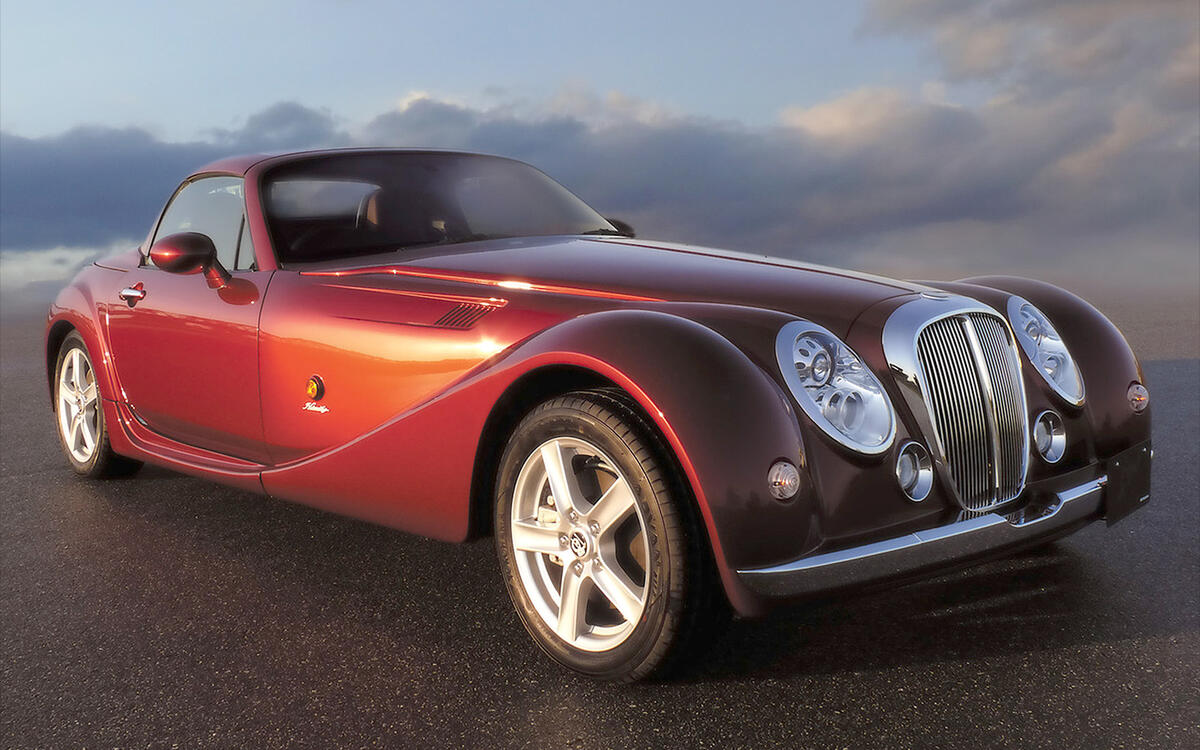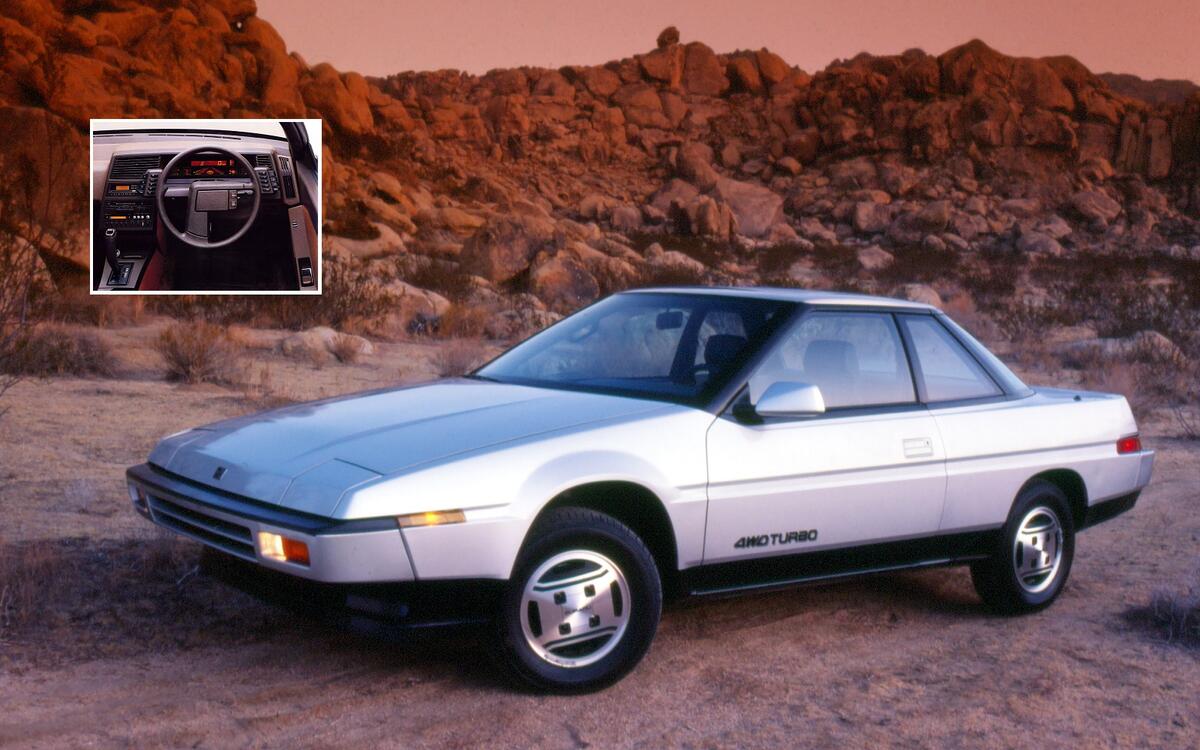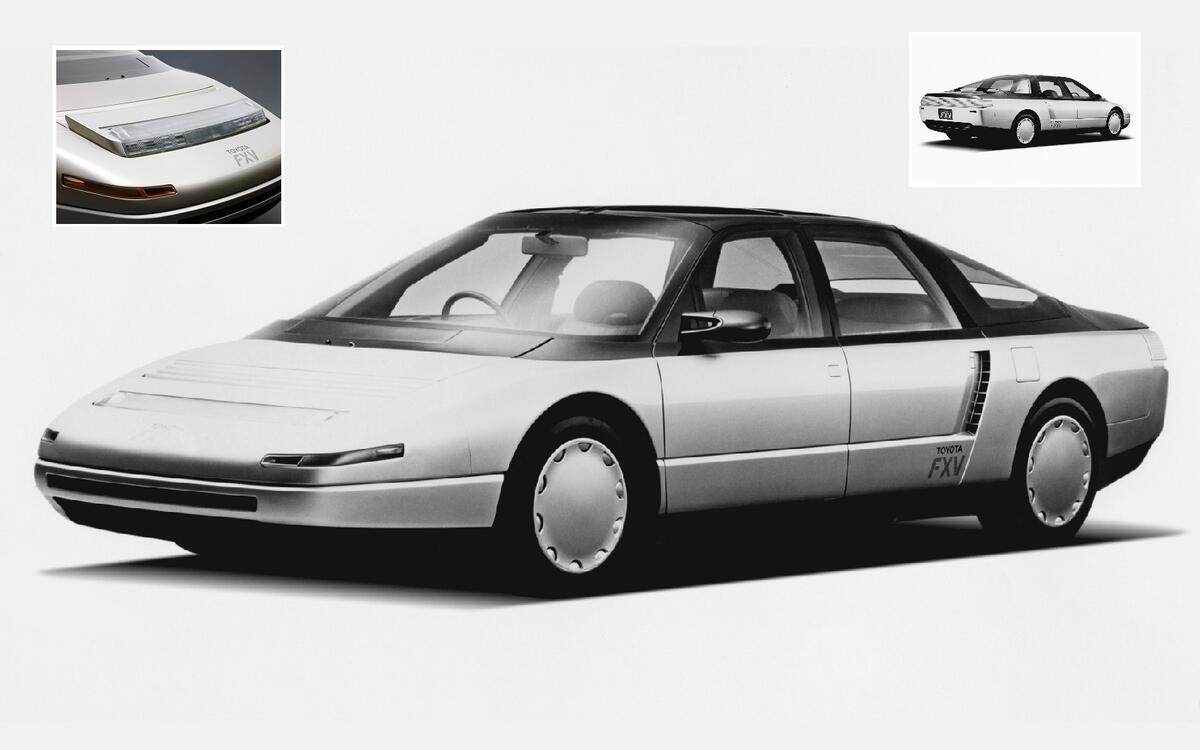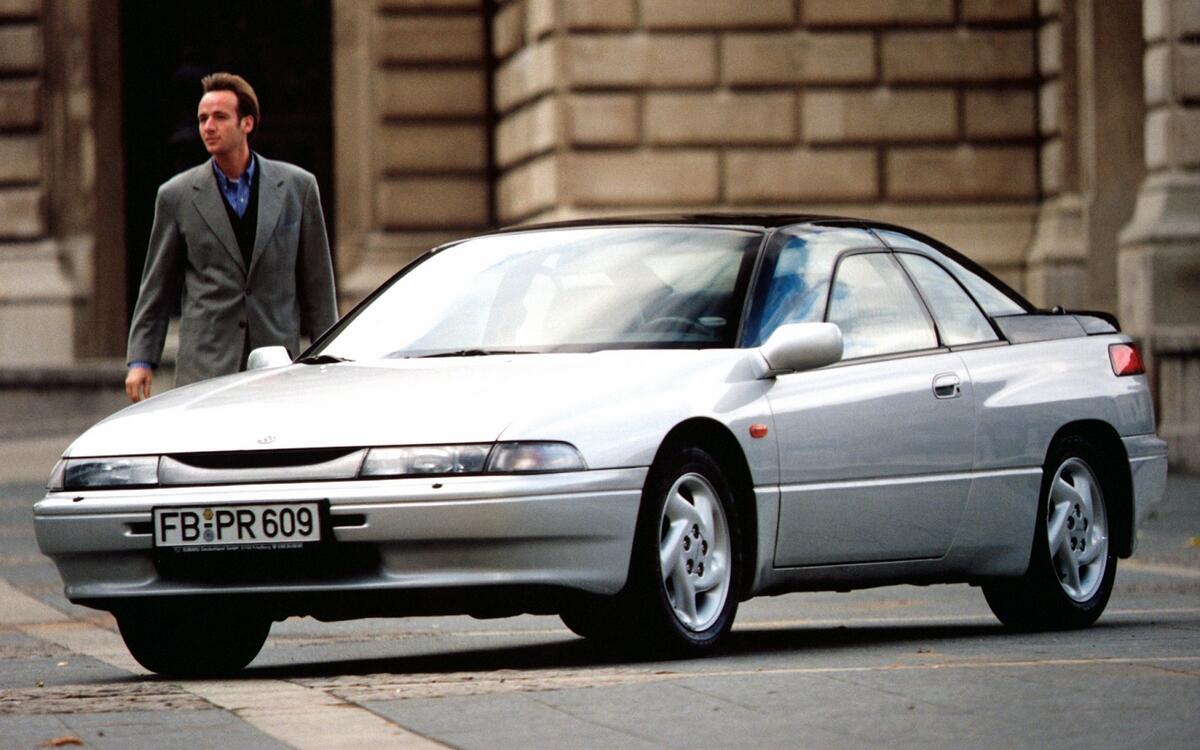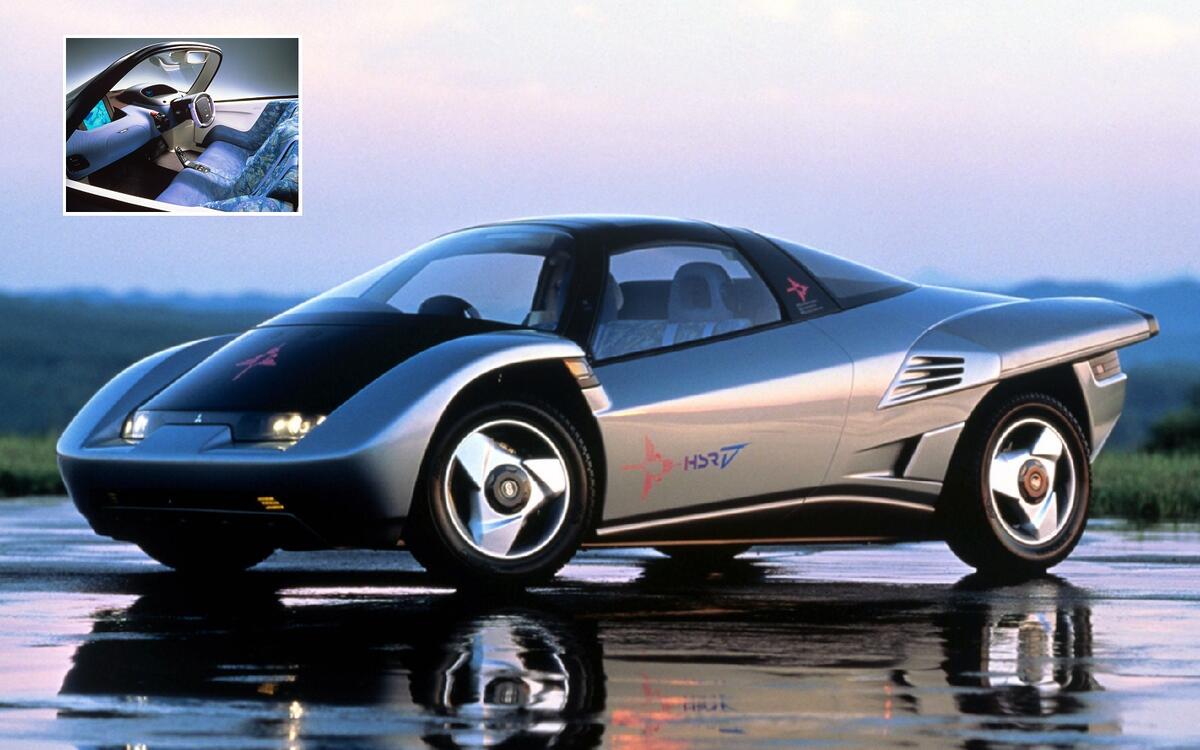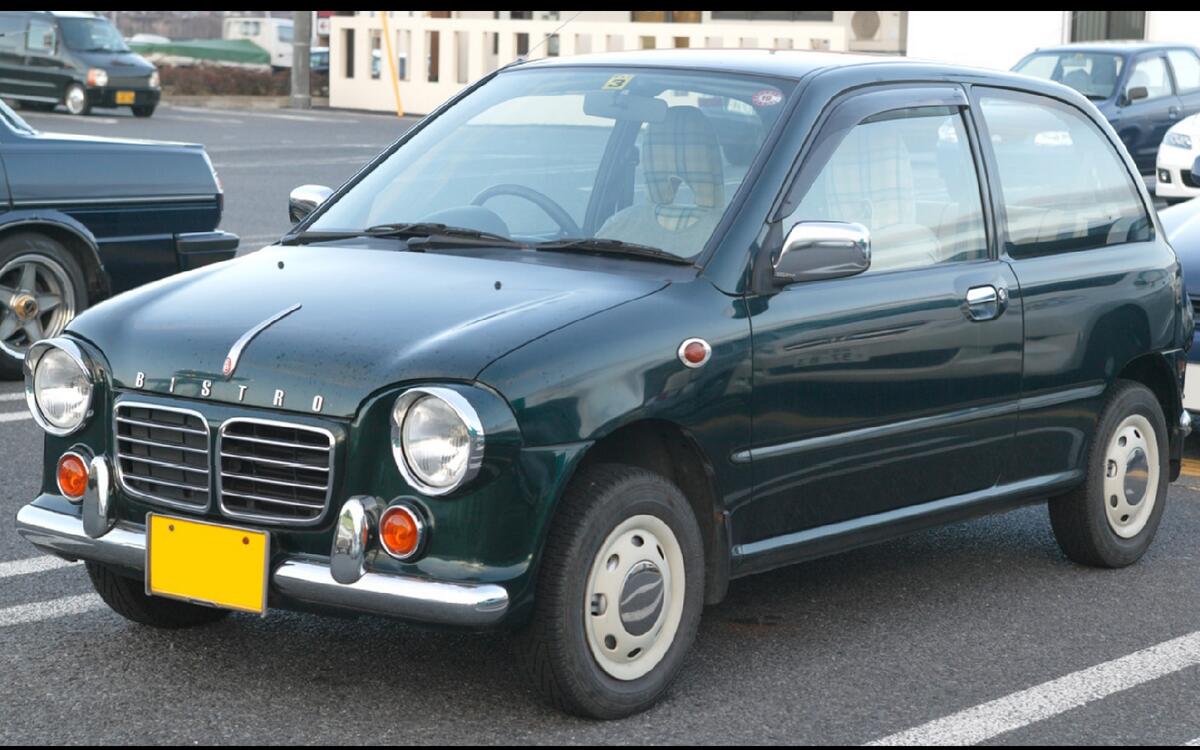 Slide of
Slide of
Japanese car makers are known for thinking outside the box when it comes to design.
It hasn’t always been that way. In the 1970s, many of Japan’s biggest car companies settled for manufacturing lookalikes of American and European cars. They individually began paving their own styling avenue during the 1980s and most had forged a strong design identity by the turn of the 1990s.
Join us for a look at some of the wildest and most unusual designs from the country that gave the world bento boxes, Pokemon and bonsai trees:
 Slide of
Slide of
Subaru XT (1985)
Subaru hoped the XT released in 1985 would allow it to navigate away from its economy car roots and into more premium segments of the market. To make a strong visual impact, the XT's designers drew a wedge-shaped silhouette that made it look like a doorstop. Inside, the striking design continued with a steering wheel fitted with a pair of asymmetrical spokes and, on some models, a digital instrument cluster.
Sitting in the XT felt almost like piloting a jet. The result was a coupe that looked and felt like nothing else on the road during the 1980s.
 Slide of
Slide of
Toyota FXV concept (1985)
The Future eXperimental Vehicle (FXV) concept Toyota introduced in 1985 was built to explore what the family car of the 21st century could look, feel and drive like. Some of the company’s predictions were surprisingly accurate; the FXV came with a head-up display and touch screens that let the front passengers perform a variety of functions including setting the climate control.
Visually, it was shaped like a four-door supercar with a low front end, a glass greenhouse and cooling vents in front of the rear wheels that directed air to a four-cylinder engine that was both turbocharged and supercharged. The headlights were replaced by wide panel that popped out from the front end to illuminate the road ahead.
 Slide of
Slide of
Nissan Boga (1989)
Nissan seemingly designed the Boga concept for motorists who wanted a people-mover but didn't want to be seen in something that looked like a van. Presented at the 1989 Tokyo auto show, it was an experiment that explored how city cars might evolve during the 1990s. The relatively tall roof cleared up a generous amount of space for the passengers while the unusually large windows gave them a scenic view of whatever designers imagined major urban centers would look like during the 1990s.
The passengers took in the outside world while sitting on on sofa-like seats and the driver faced a fully digital instrument cluster. While the Boga's design remained at the concept stage, for better or worse, its technology was surprisingly far ahead of its time. Nissan embedded fingerprint sensors in the door skins to let the passengers access the cabin. In 2019, fingerprint recognition technology is common in the smartphone world and tech and car companies are barely beginning to incorporate this solution into production models.
 Slide of
Slide of
Nissan S-Cargo (1989)
The Nissan S-Cargo unabashedly channeled the spirit of the Citroën 2CV with styling cues like headlights that stuck out from the body, pronounced front wheel arches and two-part windows. The van-like body style echoed the 2CV trucklet sold for decades but the canvas top was reminiscent of the standard 2CV, which was still in production when the S-Cargo made its debut at the 1989 Tokyo auto show.
Even its name was a tribute to Citroën's people’s car. While it stands for small cargo, S-Cargo is pronounced like the French word for snail (escargot), which is one of the 2CV’s nicknames.
The funky, almost anime-like sheet metal hid a platform shared with the Sunny, a model known as the Sentra in America. About 8000 examples of the S-Cargo were built during a two-year production run. Manufacturing took place in the Pike factory which also built the equally head-turning Figaro and Pao.
 Slide of
Slide of
Mitsubishi Minica Toppo (1990)
Mitsubishi found a market for a spacious, versatile camper that complied with Japan's restrictive kei car regulations. It was aimed at motorists who either couldn’t afford or couldn’t find space for the relatively big Delica van. The company filled this void when it released the Minica Toppo in 1990. The model was closely related to the standard Minica but it stood out with a much taller roof that almost made it look like an American ice cream truck that shrunk in the wash.
The Minica Toppo got even weirder in 1996 when Mitsubishi surfed the retro car wave by releasing a generically retro-inspired variant of the model named Town Bee.
 Slide of
Slide of
Toyota Sera (1990)
Toyota envisioned the Sera it released in 1990 as an attainable, user-friendly coupe with supercar-like features. At first glance, it stood out from other coupes in its price bracket with a greenhouse made almost entirely out of glass. Its party trick was a pair of dihedral doors that swung open upwards to let the occupants access the cabin. It was an unusual feature that later inspired Gordon Murray, the man who designed the McLaren F1.
 Slide of
Slide of
Subaru SVX (1991)
Subaru put Italdesign in charge of drawing the SVX, a coupe developed to replace the XT at the top of the firm’s range. Stylists accurately sensed the boxy, angular trend was fading so they took the SVX’s design in a more rounded direction without settling for a look that could be qualified as conventional. The SVX’s window-within-a-window setup gave it a futuristic, concept car-like look while giving the occupants a clear view of the outside world.
Subaru displayed an SVX-based shooting brake named Amadeus at several auto shows during the early 1990s. The model was seriously considered for production, and it could have been offered in two- and four-door variants, but it ultimately remained at the concept stage.
 Slide of
Slide of
Mitsubishi HSR-V concept (1995)
Mitsubishi launched a family of forward-thinking concept cars named Highly Sophisticated-transport Research (HSR) in 1987. Aptly named HSR-V, the fifth installment was the least conventional member of the series. While its predecessors arrived as coupes or convertibles, the V looked like a Batmobile dropped on a Pajero chassis. The two-seater was never a candidate for production.
 Slide of
Slide of
Suzuki X-90 (1995)
In the 1990s, Suzuki regularly displayed its wild side on the auto show circuit but it rarely dared to launch production models that strayed from the status quo. This changed completely when the firm released the X-90 in 1995. Closely related to the Vitara, the X-90 was a two-door coupe with the roof height and ground clearance of an SUV. Vitara-sourced hardware gave it a decent amount of off-road prowess and motorists could remove the two roof panels to turn it into a quasi-convertible.
The X-90 perfectly illustrated the term “niche model” and sales were accordingly low. Often ridiculed, it was famously used as a promotional vehicle by Red Bull because its coupe-like proportions allowed the firm to mount a huge replica of its energy drink can directly over the body. In hindsight, the X-90 was born ahead of its time. In 2019, automakers are filling their line-up with as many SUV off-shoots as possible and we wouldn't be surprised if one revisits the X-90's niche sooner or later.
 Slide of
Slide of
Subaru Vivio Bistro (1995)
There was absolutely nothing ground-breaking or exciting about the Subaru Vivio unveiled in 1992. The Japanese firm attempted to turn the car into a fashion statement when it released a variant named Bistro whose design drew inspiration from classic British cars. Stylist redesigned the front end with an insert that looked like a metal bumper, round lights and one of two grille designs. Some even came with BISTRO lettering directly above the grille. Out back, the Vivio again received round lights and a metal-look bumper.
In Japan, the bigger Impreza received the same treatment and the Casa Blanca name.
 Slide of
Slide of
Daihatsu Midget II (1996)
Strict kei car regulations have forced Japanese automakers to release models that are tall and narrow. The Daihatsu Midget II unveiled in 1996 takes those proportions to a new level. Available with one or two seats, it’s a tiny pickup with a front-mounted spare wheel and headlights that remind us of the Citroën 2CV. The Midget II – which fits in the back of a Ford F-150 – was available until 2001.
 Slide of
Slide of
Mazda MS-X concept (1997)
The segment-bending Multipurpose Sedan eXperimental (MS-X) concept Mazda unveiled at the 1997 Frankfurt auto show put a more versatile spin on the concept of a family car. It looked like designers chopped the front and the rear end off of a four-door passenger car and welded them to the middle section of a minivan. The result was not exactly congruous but Mazda argued the MS-X effortlessly blended comfort and driving dynamics.
Inside, motorists could use a navigation system to get to their destination without making a wrong turn while a chip card loaded individual user’s preference, like the seating position, when inserted into the dashboard. While Mazda has never made a car that looks anything like the MS-X, many of its tech features have since trickled down to production models.
 Slide of
Slide of
Honda Life (1998)
Honda’s designs have often been less off-beat than many of its rivals’. The third-generation Life released in 1998 is one of the exceptions. The sizable grille chiseled into its front bumper and tall-mounted headlights emphasized its height. Out back, the vertical lights had the same effect. It looked like a city car doing its best impression of the HR-V, which was also released in 1998.
 Slide of
Slide of
Honda Fuya-Jo concept (1999)
Presented at the 1999 Tokyo auto show, the Honda Fuya-Jo concept put an unexpected spin on the traditional city car. Its interior was designed to resemble a night club. The four occupants sat on individual seats propped up like bar stools while listening to music from speakers integrated into the door panels. Visually, it looked like a cross between a purple toaster oven, a freight train and a custom pickup truck from the 1970s. Honda never considered turning the Fuya-Jo concept into a production model.
 Slide of
Slide of
Daihatsu Naked (1999)
Boxy and utilitarian, the Daihatsu Naked looked like a Hummer shrunk to kei car dimensions. While its design made it look like a rugged, no-nonsense off-roader, its sheet metal hid mechanical components (including a 658cc three-cylinder engine) borrowed from the Mira. All-wheel drive was available, but we wouldn’t take it on any terrain more challenging than a dirt road.
 Slide of
Slide of
Daihatsu Mira Gino (1999)
The original Mini celebrated its 40th birthday in 1999. It was seriously outdated compared to other city cars in its price range and Rover promised a new model developed with input from BMW was around the corner. Daihatsu quietly beat the British firm to the punch when it turned the Mira into a fashionable city car named Gino whose design was markedly inspired by the Mini.
Surprisingly, no one at Rover batted an eyelash when the Gino made its debut. It was successful enough to warrant the development of a second-generation model unveiled in 2004. This time, it borrowed styling cues from the first generation of the BMW-designed Mini. It was sold in select European markets as the Trevis.
 Slide of
Slide of
Toyota WiLL Vi (1999)
After years of making humdrum cars like the Camry and the Corolla, Toyota shocked the public and the press by launching a design-led sub-brand named WiLL in 1999. It released three cars named Vi, VS and Cypha, respectively. All of them stood out with styling best described as unconventional but the Vi made in 2000 and 2001 took originality to the next level with an angular design highlighted by a reverse-raked rear window. Mechanically, it was related to the first-generation Yaris.
The WiLL Vi's origami-like sheet metal made it interesting to look at but few motorists felt comfortable being seen in one. Production ended much sooner than expected.
 Slide of
Slide of
Suzuki Twin (2003)
The Suzuki Twin was small even by kei car standards. Stretching slightly longer than a Smart ForTwo, its rounded design blurred the line between a real car that motorists could commute in and a plastic model you’d find in the toddler aisle at Toys R’ Us. It was sold exclusively in Japan where it was available with a hybrid powertrain. Suzuki notably fitted the hybrid Twin with a single power-operated window to reduce energy use and boost efficiency.
 Slide of
Slide of
Mitsuoka Nouera (2004)
Coachbuilder Mitsuoka achieved international fame by turning run-of-the-mill cars into head-turning, extroverted creations often characterized by a retro design. Released in 2004, the Nouera was based on the Honda Accord but the two models shared almost no styling cues. Up front, Mitsouka added round lights and a tall grille with a chrome frame to capture the design essence of classic British cars.
Its designers took the back end in a different direction; the Nouera almost resembled two different cars fused into one and for all we know it might be. What’s undeniable is that it’s anything but conventional.
 Slide of
Slide of
Suzuki Hustler (2014)
Suzuki envisioned the Hustler as a city car for motorists with an active lifestyle. Its front end is vaguely reminiscent of the Toyota FJ Cruiser and the available two-tone paint job stresses the resemblance. It’s more capable than its proportions suggest; Suzuki offers it with four-wheel drive and a hill-descent control system. The Hustler went on sale in Japan in 2014 and it’s still available as of 2019.
 Slide of
Slide of
Mitsuoka Himiko (2018)
Look closely and you’ll notice the Mitsuoka Himiko started life as a third-generation Mazda MX-5 Miata. The doors and the windshield frame are sourced directly from the Mazda parts bin; the interior is standard Miata fare, too. Beyond that, the two-seater has been noticeably stretched into a more modern (and almost caricatural) take on a member of the Morgan family. The Mini-sourced headlights notably create an additional visual link between the Himiko and the Aero 8.
Powered by a Miata-sourced four-cylinder engine, the Himiko is sold in a handful of countries including Japan and the United Kingdom, where it’s called Roadster. Pricing starts at £24,990 (about $32,500).
These quirky cars shattered the status quo, and moved the look of Japanese car design on, one way or another
Advertisement


